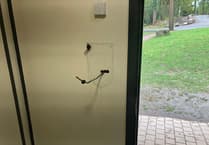An investigation is underway after endangered fish were found dead in the Cinderford and Soudley Brook area.
Forestry England and the Environment Agency are working to find the cause of the deaths of several endangered and legally protected native white-clawed crayfish were found dead.
It is expected that the cause of death is Crayfish Plague which is a deadly and very infectious disease for white claws.
Crayfish Plague is not harmful to humans or other animals.
Forestry England is asking people visiting the streams to take steps to ensure they do not pass on the disease.
Do not allow dogs to swim in surrounding waters, do not use damp equipment in another stream, clean off mud or vegetation, thoroughly dry equipment and treat with disinfectant.
White clawed Crayfish look like miniature lobsters, they hide away under rocks and logs during the day and emerge during the night to eat.
They are the largest native, freshwater invertebrate but are now rare in Britain.
The few remaining populations of white-clawed crayfish are very vulnerable to this disease and also face local extinction due to competition from non-native crayfish species and loss of habitat.
Once crayfish plague is present in a watercourse the white-clawed crayfish will usually all succumb to the disease.
This may occur over several weeks as the fungus is spread by contact between individual, white-clawed crayfish, through the water or contact with infected mud.
The Crayfish Plague fungal spores can live without a crayfish host for 22 days in the water or on damp clothes or equipment.
The disease can be transferred to white clawed crayfish in other parts of the catchment via water and mud on damp clothes, footwear, bike tyres, vehicle tyres, fishing or boating equipment or any machinery, or by dogs, horses or livestock.
You can report sightings of dead crayfish via the incident hotline: 0800 80 70 60.
Do not handle or remove live or dead crayfish. It is illegal to do this without a licence.
An investigation is underway after endangered fish were found dead in the Cinderford and Soudley Brook area.
Forestry England and the Environment Agency are working to find the cause of the deaths of several endangered and legally protected native white-clawed crayfish were found dead.
It is expected that the cause of death is Crayfish Plague which is a deadly and very infectious disease for white claws.
Crayfish Plague is not harmful to humans or other animals.
Forestry England is asking people visiting the streams to take steps to ensure they do not pass on the disease.
Do not allow dogs to swim in surrounding waters, do not use damp equipment in another stream, clean off mud or vegetation, thoroughly dry equipment and treat with disinfectant.
White clawed Crayfish look like miniature lobsters, they hide away under rocks and logs during the day and emerge during the night to eat.
They are the largest native, freshwater invertebrate but are now rare in Britain.
The few remaining populations of white-clawed crayfish are very vulnerable to this disease and also face local extinction due to competition from non-native crayfish species and loss of habitat.
Once crayfish plague is present in a watercourse the white-clawed crayfish will usually all succumb to the disease.
This may occur over several weeks as the fungus is spread by contact between individual, white-clawed crayfish, through the water or contact with infected mud.
The Crayfish Plague fungal spores can live without a crayfish host for 22 days in the water or on damp clothes or equipment.
The disease can be transferred to white clawed crayfish in other parts of the catchment via water and mud on damp clothes, footwear, bike tyres, vehicle tyres, fishing or boating equipment or any machinery, or by dogs, horses or livestock.
You can report sightings of dead crayfish via the incident hotline: 0800 80 70 60.
Do not handle or remove live or dead crayfish. It is illegal to do this without a licence.




Comments
This article has no comments yet. Be the first to leave a comment.